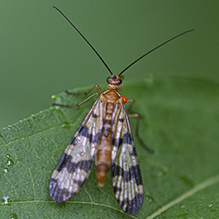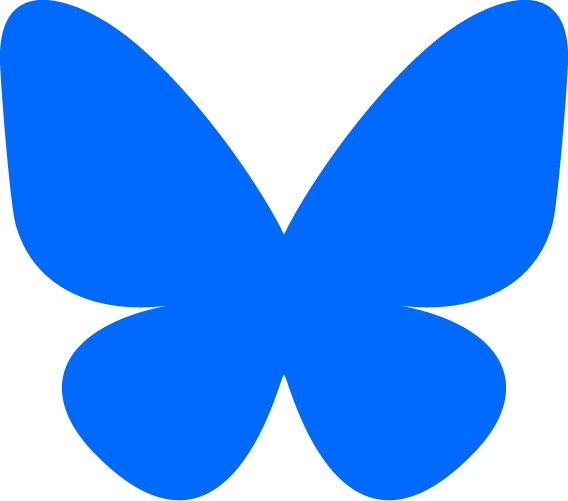Minnesota Scorpionflies, Hangingflies,
and Allies

Order Mecoptera
Mecoptera is an order of small to medium-sized insects. insects. There are about 600 Mecoptera species on 34 genera in 9 families worldwide, 85 species in 11 genera in 5 families in North America north of Mexico, and at least 18 species in 4 genera in 4 families in Minnesota.
Mecoptera is an order of insects that is most often described in terms of characteristics that its members do not have. According to the World Checklist of Extant Mecoptera Species, the defining characteristics of Mecoptera are:
Hindwings are not modified into small halteres, as in Diptera. Forewings are not modified into sclerotized wing covers, as in Coleoptera. Wings are not covered with hairs or scales, as in Trichoptera and Lepidoptera. Their bodies are not strongly flattened and sclerotized for an ectoparasitic mode of existence, as in fleas. Forewings are similar in size and shape, unlike Hymenoptera. Wings usually do not have reticulate venation, with apical forks and twiggings, as in Neuroptera and Megaloptera. The thorax is not elongate, as in Raphidioptera (snake-flies). However, many of the modern families of Mecoptera have the mouthparts extended into an elongate rostrum.
Mecoptera order currently includes scorpionflies, hangingflies, and the earwigfly or forcepfly. The morphological diversity of the order suggests that it will eventually be reorganized as several groups. A 2002 DNA study suggests that the order Siphonaptera (fleas) should be included in this order, but this has not been widely adopted.
Recent Additions
There are fifteen species of snow scorpionflies (Family Boreidae) worldwide, thirteen species in North America, two in eastern United States including Minnesota. The two species in our state are both in the genus Boreus and are easily told apart by their color.
Mid-winter boreus (Boreus brumalis) is a small snow scorpionfly. It is common in the United States from Maine to Michigan, south to Tennessee, and in Canada in Nova Scotia and Ontario. There are isolated populations in Illinois, Wisconsin, and Minnesota. They are found in deciduous woodlands that have moss on the ground.
Larvae live in moss and prey on small insects and other animals found in the moss, and possibly also on the moss. Adults prey on small insects and other animals found hibernating under stones and moss. They are seen on the surface of the snow on winter days when the temperature is above freezing feeding on other winter insects.
Other Recent Additions
This list includes only scorpionflies, hangingflies, and allies that have been recorded in Minnesota, but not all of the scorpionflies, hangingflies, and allies found in Minnesota.
| Profile | Photo | Video | |||
|---|---|---|---|---|---|
anomalous scorpionfly (Panorpa anomala) |
|
||||
Bank’s scorpionfly (Panorpa banksi) |
|||||
brand-winged hangingfly (Bittacus stigmaterus) |
|||||
clear-winged scorpionfly (Panorpa claripennis) |
|||||
clouded scorpionfly (Panorpa nebulosa) |
|||||
common scorpionfly (Panorpa insolens) |
|||||
common scorpionfly (Panorpa setifera) |
|||||
common scorpionfly (Panorpa sigmoides) |
|||||
common scorpionfly (Panorpa speciosa) |
|||||
forcepfly (Merope tuber) |
|||||
forked scorpionfly (Panorpa subfurcata) |
|||||
hairy-horned hangingfly (Bittacus pilicornis) |
|||||
hooded scorpionfly (Panorpa galerita) |
|||||
snow-born boreus (Boreus nivoriundus) |
|||||
thin hangingfly (Bittacus strigosus) |
Bittacus pilicornis (hairy-horned hangingfly)
Bittacus stigmaterus (brand-winged hangingfly)
Bittacus strigosus (thin hangingfly)
Boreus brumalis (mid-winter boreus)
Boreus nivoriundus (snow-born boreus)
Merope tuber (forcepfly)
Panorpa anomala (anomalous scorpionfly)
Panorpa banksi (Bank’s scorpionfly)
Panorpa claripennis (clear-winged scorpionfly)
Panorpa galerita (hooded scorpionfly)
Panorpa helena (Helena’s scorpionfly)
Panorpa insolens (common scorpionfly)
Panorpa nebulosa (clouded scorpionfly)
Panorpa setifera (common scorpionfly)
Panorpa sigmoides (common scorpionfly)
Panorpa speciosa (common scorpionfly)
Panorpa spp. (common scorpionflies)
Panorpa subfurcata (forked scorpionfly)
No Species Page Yet?
If you do not see a linked page for a species in the list at left you can still upload a photo or video or report a sighting for that species. Click on one of the buttons below and type in the common name and/or scientific name of the species in your photo, video, or sighting. A new page will be created for that species featuring your contribution.
These buttons not working for you?
Simply email us at info@MinnesotaSeasons.com.




_12it.jpg)



